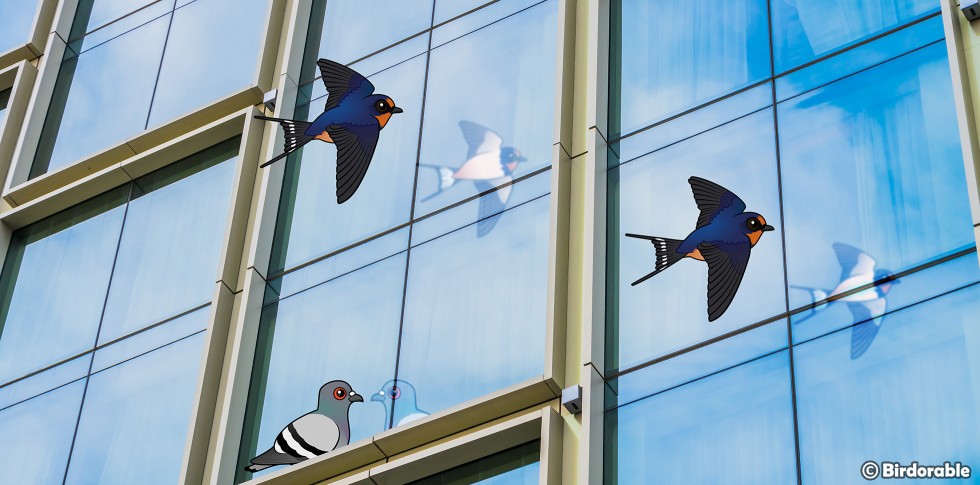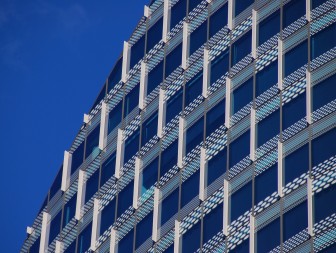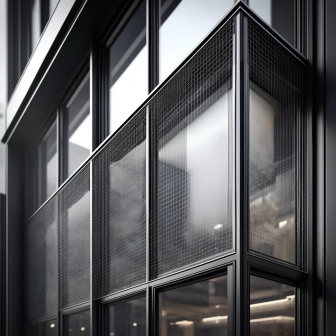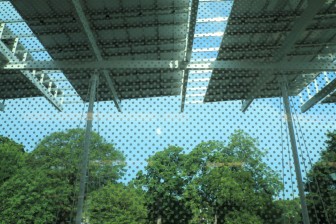Infrastructure Week 2024
Designing with Birds in Mind: Solutions for Safer Glass Structures

It's Infrastructure Week on our blog! The series will dive into the fascinating intersection of urban development and bird conservation and other topics related to infrastructure and birds. As our cities expand and evolve, so too does the need to consider our feathered friends in our architectural and landscaping decisions. From bridges that serve as nesting grounds to green roofs that offer safe havens, we'll explore how modern infrastructure relates to birds.
Birds brighten our skies with their vibrant colors and melodious songs, but they face numerous dangers as they navigate a world increasingly dominated by human infrastructure. As we expand our cities and networks, we create hazards that pose serious threats to avian populations. Among the most pressing concerns are collisions with glass buildings. Thankfully, innovative solutions and architectural designs are emerging that can mitigate these risks, offering hope for safer skies for our feathered friends.

Fritted glass on the JP Morgan Building in Sydney by Rob Deutscher [CC BY 2.0 Deed]
Glass buildings, with their sleek and modern aesthetics, are a staple of urban architecture. However, they pose a significant hazard to birds. The transparent and reflective properties of glass can deceive birds into thinking they're flying towards open sky or habitat, leading to collisions that are often fatal. Each year, it's estimated that millions of birds die from striking glass surfaces. Cities along major migration flyways can be major zones of bird mortality during the spring and fall. This issue has garnered attention from conservationists, architects, and city planners who are all working towards making buildings safer for our feathered friends.
One of the primary reasons glass buildings are so dangerous to birds is that birds don't perceive glass as a barrier. The reflections of trees, sky, and other natural elements on glass surfaces can create an illusion of continuity in their habitat. When birds try to fly through these illusions, they collide with the hard, unyielding glass. Furthermore, during nighttime, interior lights confuse and attract nocturnal migrants, compounding the risk of collisions.

Netting to make windows safer for birds
Addressing this issue, several innovative solutions and architectural adjustments can be implemented to help reduce bird collisions with glass buildings:
-
Fritted Glass: This type of glass has patterns etched onto it that are visible to birds but minimally intrusive to human eyes. The patterns can take various forms such as dots, lines, or images that cover enough surface area to alert birds of the barrier ahead.
-
Angled Glass: Installing glass at an angle can help reduce reflections of the sky and vegetation, which are often the visual cues that mislead birds. Angled glass reduces the severity of these reflections, making the surface more visible to birds as an obstacle.
- External Screens and Netting: Installing screens or netting in front of glass surfaces can physically prevent birds from colliding with the glass. This method doesn't alter the glass itself but provides a barrier that birds can see and avoid.
-
UV-reflective Glass: Birds can see ultraviolet light, which is invisible to humans. Glass treated to reflect ultraviolet light can appear clear to humans but is visible to birds. This technology allows buildings to maintain their transparency for people while being an effective deterrent against bird strikes.

Bird-safe glass with decals by Kendeda Building | Shan Arora [CC BY 2.0 Deed]
-
Decals and Window Films: Placing decals or special films on glass surfaces can make windows visible to birds without significantly affecting the view from inside. These decals are often placed in specific patterns that provide cues to birds that there is a barrier.
-
Lighting Reduction: Reducing light pollution, especially during migration seasons, can decrease the number of birds attracted to and disoriented by glass buildings at night. Many cities are adopting guidelines that include turning off building lights or dimming them during critical migration periods.
Community involvement is also crucial. Initiatives like bird conservation programs and educational campaigns can raise awareness about the importance of bird-friendly designs. By supporting policies that require or encourage such measures, the public can play a pivotal role in promoting safer environments for birds.
During this infrastructure week, as we continue to build and innovate, it's vital that we consider our impact on the natural world. With thoughtful design and technological advances, we can create infrastructures that not only serve human needs but also protect our avian companions. Ensuring the safety of birds as they navigate the challenges of modern landscapes is not just an act of conservation; it's a commitment to preserving the beauty and diversity of life on Earth.
Further reading:





Comments
Leave a comment
Thank you!